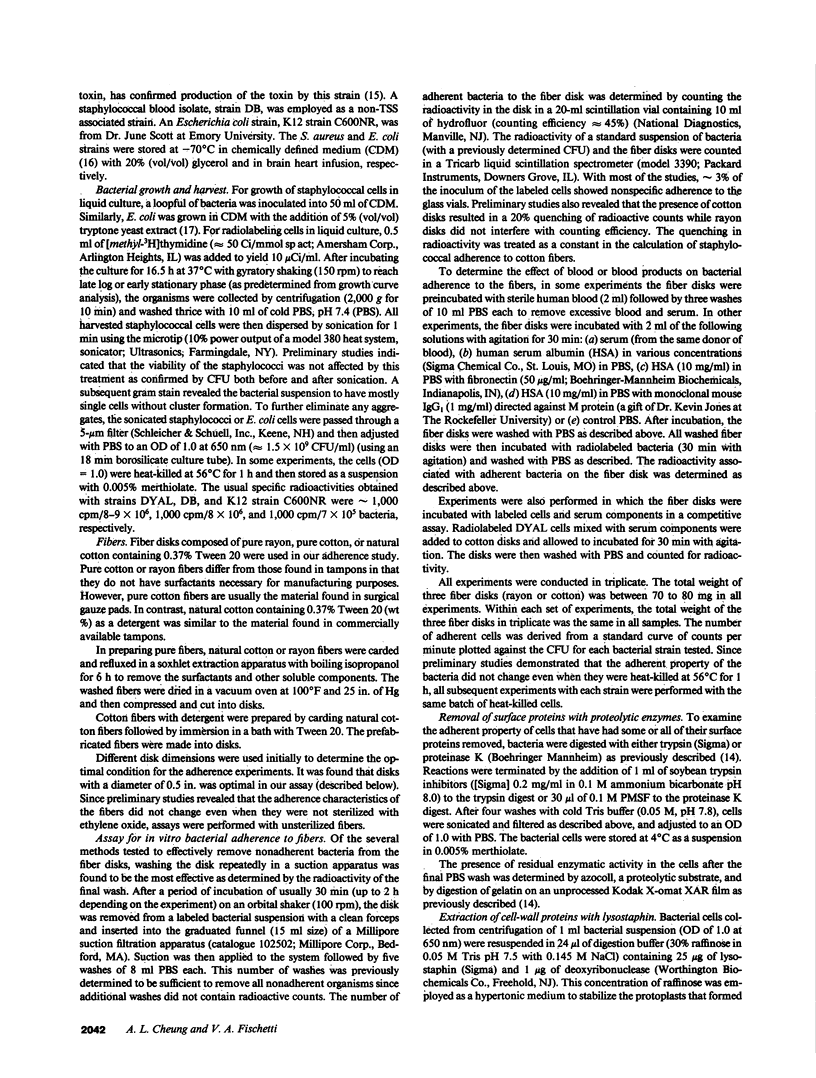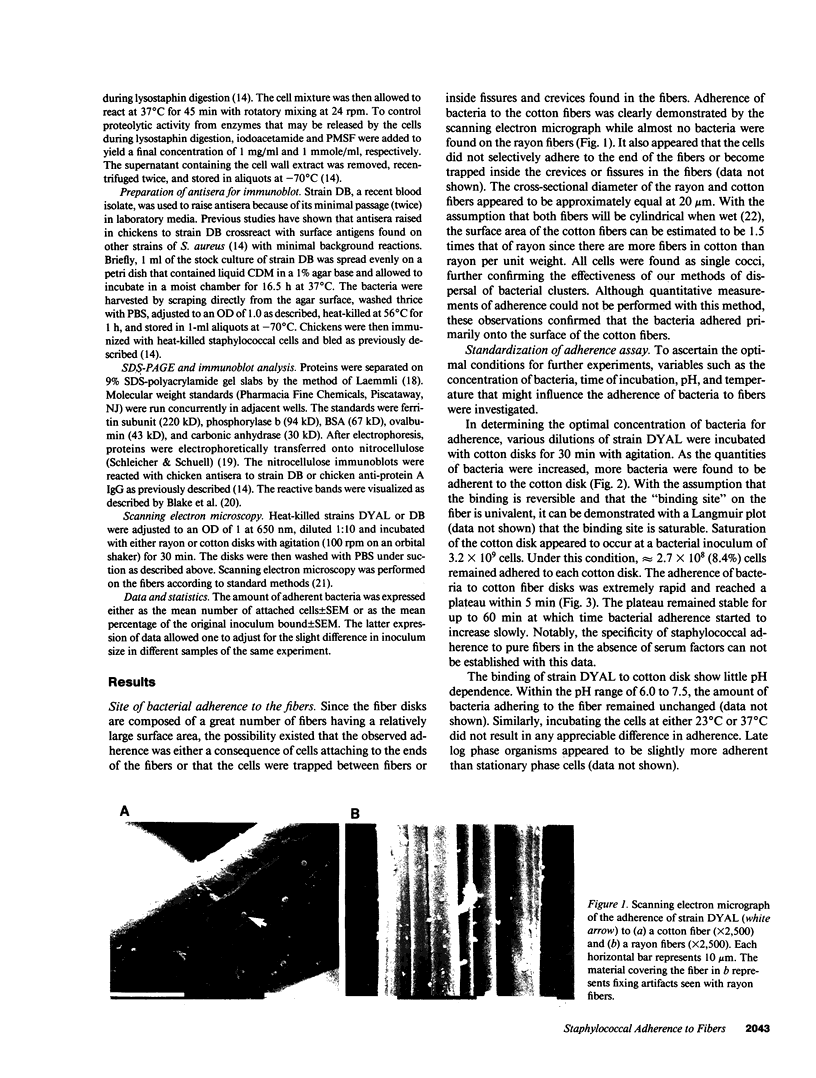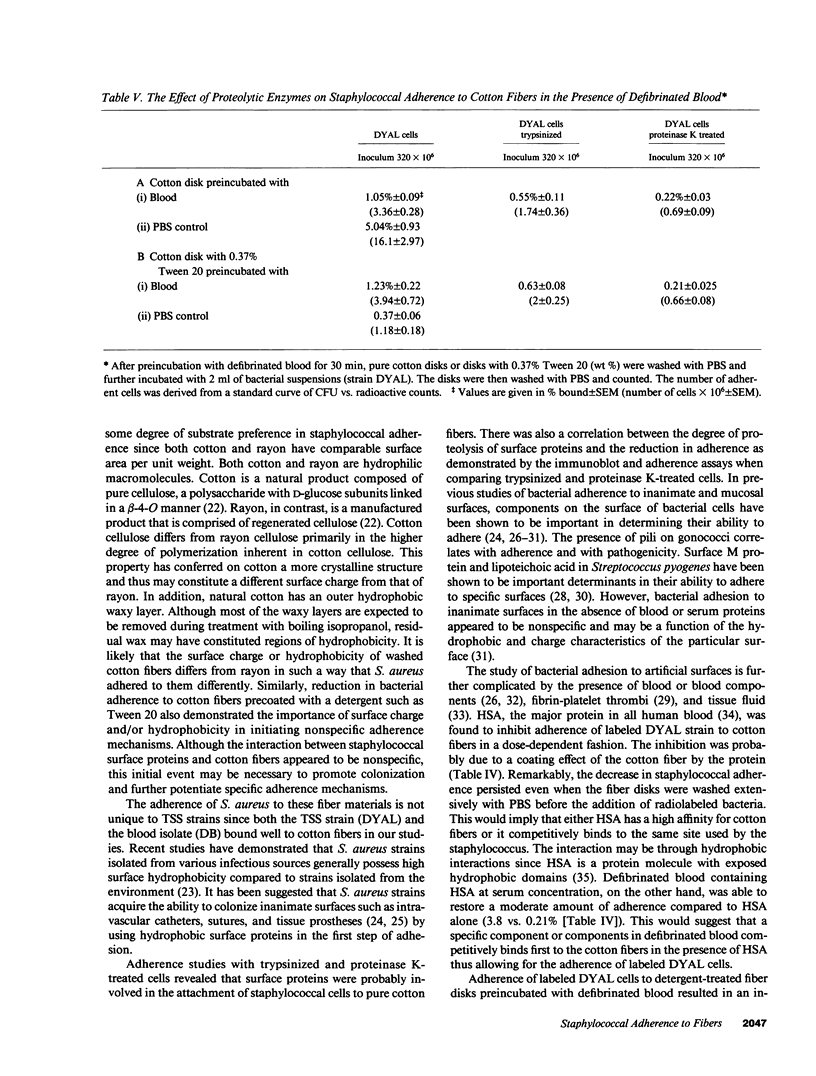Abstract
To study the role of surface proteins in the adherence of Staphylococcus aureus to fibers that are used in tampon and surgical gauze pad manufacture, we have developed an adherence assay with S. aureus cells and cotton and rayon fibers. Results suggest that staphylococcal adherence is dependent on both the substrate and the material used to coat these fibers. Scanning electron micrographs supported the adherence results and revealed more cells on the surface of cotton than rayon fibers. Treatment of staphylococcal cells with proteolytic enzymes significantly reduced binding to pure cotton and detergent-treated cotton fibers. Immunoblot analysis of cell wall proteins suggested that surface proteins in the mol wt range of 120-220 kD were involved in the adherence of S. aureus to cotton fibers. Although the adherence of S. aureus to cotton fibers alone appeared to be mediated through surface charge or hydrophobic interactions, bacterial binding to fibers which have been pretreated with defibrinated blood appeared to be more specific and independent of the surface constituents of the fibers. The results of these studies implicate staphylococcal surface proteins in the adherence of S. aureus to commercially available tampon fibers and surgical gauze pads.
Full text
PDF








Images in this article
Selected References
These references are in PubMed. This may not be the complete list of references from this article.
- Arko R. J., Rasheed J. K., Broome C. V., Chandler F. W., Paris A. L. A rabbit model of toxic shock syndrome: clinicopathological features. J Infect. 1984 May;8(3):205–211. doi: 10.1016/s0163-4453(84)93859-3. [DOI] [PubMed] [Google Scholar]
- BUSSING H. J. Zur Biochemie des Menstrualblutes. Zentralbl Gynakol. 1957 Mar 23;79(12):456–467. [PubMed] [Google Scholar]
- Barrett S. P. Protein-mediated adhesion of Staphylococcus aureus to silicone implant polymer. J Med Microbiol. 1985 Oct;20(2):249–253. doi: 10.1099/00222615-20-2-249. [DOI] [PubMed] [Google Scholar]
- Beachey E. H., Ofek I. Epithelial cell binding of group A streptococci by lipoteichoic acid on fimbriae denuded of M protein. J Exp Med. 1976 Apr 1;143(4):759–771. doi: 10.1084/jem.143.4.759. [DOI] [PMC free article] [PubMed] [Google Scholar]
- Bell J. A., Pennington T. H., Petrie D. T. Western blot analysis of staphylococcal antibodies present in human sera during health and disease. J Med Microbiol. 1987 Mar;23(2):95–99. doi: 10.1099/00222615-23-2-95. [DOI] [PubMed] [Google Scholar]
- Blake M. S., Johnston K. H., Russell-Jones G. J., Gotschlich E. C. A rapid, sensitive method for detection of alkaline phosphatase-conjugated anti-antibody on Western blots. Anal Biochem. 1984 Jan;136(1):175–179. doi: 10.1016/0003-2697(84)90320-8. [DOI] [PubMed] [Google Scholar]
- Blomster-Hautamaa D. A., Kreiswirth B. N., Kornblum J. S., Novick R. P., Schlievert P. M. The nucleotide and partial amino acid sequence of toxic shock syndrome toxin-1. J Biol Chem. 1986 Nov 25;261(33):15783–15786. [PubMed] [Google Scholar]
- Broome C. V., Hayes P. S., Ajello G. W., Feeley J. C., Gibson R. J., Graves L. M., Hancock G. A., Anderson R. L., Highsmith A. K., Mackel D. C. In-vitro studies of interactions between tampons and Staphylococcus aureus. Ann Intern Med. 1982 Jun;96(6 Pt 2):959–962. doi: 10.7326/0003-4819-96-6-959. [DOI] [PubMed] [Google Scholar]
- Chesney P. J., Bergdoll M. S., Davis J. P., Vergeront J. M. The disease spectrum, epidemiology, and etiology of toxic-shock syndrome. Annu Rev Microbiol. 1984;38:315–338. doi: 10.1146/annurev.mi.38.100184.001531. [DOI] [PubMed] [Google Scholar]
- Cheung A. L., Fischetti V. A. Variation in the expression of cell wall proteins of Staphylococcus aureus grown on solid and liquid media. Infect Immun. 1988 May;56(5):1061–1065. doi: 10.1128/iai.56.5.1061-1065.1988. [DOI] [PMC free article] [PubMed] [Google Scholar]
- Ellen R. P., Gibbons R. J. M protein-associated adherence of Streptococcus pyogenes to epithelial surfaces: prerequisite for virulence. Infect Immun. 1972 May;5(5):826–830. doi: 10.1128/iai.5.5.826-830.1972. [DOI] [PMC free article] [PubMed] [Google Scholar]
- Fischetti V. A., Jones K. F., Manjula B. N., Scott J. R. Streptococcal M6 protein expressed in Escherichia coli. Localization, purification, and comparison with streptococcal-derived M protein. J Exp Med. 1984 Apr 1;159(4):1083–1095. doi: 10.1084/jem.159.4.1083. [DOI] [PMC free article] [PubMed] [Google Scholar]
- Holland K. T., Ingham E., Eady E. A., Gowland G. Toxic shock syndrome: the effect of solid phase materials on the physiology of Staphylococcus aureus. Postgrad Med J. 1985;61 (Suppl 1):39–43. [PubMed] [Google Scholar]
- Ingham E., Eady E. A., Holland K. T., Gowland G. Effects of tampon materials on the in-vitro physiology of a toxic shock syndrome strain of Staphylococcus aureus. J Med Microbiol. 1985 Aug;20(1):87–95. doi: 10.1099/00222615-20-1-87. [DOI] [PubMed] [Google Scholar]
- Jacobson J. A., Kasworm E. M. Toxic shock syndrome after nasal surgery. Case reports and analysis of risk factors. Arch Otolaryngol Head Neck Surg. 1986 Mar;112(3):329–332. doi: 10.1001/archotol.1986.03780030093019. [DOI] [PubMed] [Google Scholar]
- Katz S., Izhar M., Mirelman D. Bacterial adherence to surgical sutures. A possible factor in suture induced infection. Ann Surg. 1981 Jul;194(1):35–41. doi: 10.1097/00000658-198107000-00007. [DOI] [PMC free article] [PubMed] [Google Scholar]
- Laemmli U. K. Cleavage of structural proteins during the assembly of the head of bacteriophage T4. Nature. 1970 Aug 15;227(5259):680–685. doi: 10.1038/227680a0. [DOI] [PubMed] [Google Scholar]
- Ljungh A., Hjertén S., Wadström T. High surface hydrophobicity of autoaggregating Staphylococcus aureus strains isolated from human infections studied with the salt aggregation test. Infect Immun. 1985 Feb;47(2):522–526. doi: 10.1128/iai.47.2.522-526.1985. [DOI] [PMC free article] [PubMed] [Google Scholar]
- Ludwicka A., Jansen B., Wadström T., Pulverer G. Attachment of staphylococci to various synthetic polymers. Zentralbl Bakteriol Mikrobiol Hyg A. 1984 Apr;256(4):479–489. doi: 10.1016/s0174-3031(84)80024-4. [DOI] [PubMed] [Google Scholar]
- Ogawa S. K., Yurberg E. R., Hatcher V. B., Levitt M. A., Lowy F. D. Bacterial adherence to human endothelial cells in vitro. Infect Immun. 1985 Oct;50(1):218–224. doi: 10.1128/iai.50.1.218-224.1985. [DOI] [PMC free article] [PubMed] [Google Scholar]
- Proctor R. A., Mosher D. F., Olbrantz P. J. Fibronectin binding to Staphylococcus aureus. J Biol Chem. 1982 Dec 25;257(24):14788–14794. [PubMed] [Google Scholar]
- Reingold A. L. Nonmenstrual toxic shock syndrome: the growing picture. JAMA. 1983 Feb 18;249(7):932–932. [PubMed] [Google Scholar]
- Reiser R. F., Hinzman S. J., Bergdoll M. S. Production of toxic shock syndrome toxin 1 by Staphylococcus aureus restricted to endogenous air in tampons. J Clin Microbiol. 1987 Aug;25(8):1450–1452. doi: 10.1128/jcm.25.8.1450-1452.1987. [DOI] [PMC free article] [PubMed] [Google Scholar]
- Robbins R. N., Reiser R. F., Hehl G. L., Bergdoll M. S. Production of toxic shock syndrome toxin 1 by Staphylococcus aureus as determined by tampon disk-membrane-agar method. J Clin Microbiol. 1987 Aug;25(8):1446–1449. doi: 10.1128/jcm.25.8.1446-1449.1987. [DOI] [PMC free article] [PubMed] [Google Scholar]
- Russell P. B., Kline J., Yoder M. C., Polin R. A. Staphylococcal adherence to polyvinyl chloride and heparin-bonded polyurethane catheters is species dependent and enhanced by fibronectin. J Clin Microbiol. 1987 Jun;25(6):1083–1087. doi: 10.1128/jcm.25.6.1083-1087.1987. [DOI] [PMC free article] [PubMed] [Google Scholar]
- Schlievert P. M., Blomster D. A., Kelly J. A. Toxic shock syndrome Staphylococcus aureus: effect of tampons on toxic shock syndrome toxin 1 production. Obstet Gynecol. 1984 Nov;64(5):666–671. [PubMed] [Google Scholar]
- Toback J., Fayerman J. W. Toxic shock syndrome following septorhinoplasty. Implications for the head and neck surgeon. Arch Otolaryngol. 1983 Sep;109(9):627–629. doi: 10.1001/archotol.1983.00800230063016. [DOI] [PubMed] [Google Scholar]
- Towbin H., Staehelin T., Gordon J. Electrophoretic transfer of proteins from polyacrylamide gels to nitrocellulose sheets: procedure and some applications. Proc Natl Acad Sci U S A. 1979 Sep;76(9):4350–4354. doi: 10.1073/pnas.76.9.4350. [DOI] [PMC free article] [PubMed] [Google Scholar]
- Toy P. T., Lai L. W., Drake T. A., Sande M. A. Effect of fibronectin on adherence of Staphylococcus aureus to fibrin thrombi in vitro. Infect Immun. 1985 Apr;48(1):83–86. doi: 10.1128/iai.48.1.83-86.1985. [DOI] [PMC free article] [PubMed] [Google Scholar]
- Vaudaux P. E., Waldvogel F. A., Morgenthaler J. J., Nydegger U. E. Adsorption of fibronectin onto polymethylmethacrylate and promotion of Staphylococcus aureus adherence. Infect Immun. 1984 Sep;45(3):768–774. doi: 10.1128/iai.45.3.768-774.1984. [DOI] [PMC free article] [PubMed] [Google Scholar]
- Wadström T. Molecular aspects on pathogenesis of wound and foreign body infections due to staphylococci. Zentralbl Bakteriol Mikrobiol Hyg A. 1987 Aug;266(1-2):191–211. doi: 10.1016/s0176-6724(87)80032-9. [DOI] [PubMed] [Google Scholar]
- van de Rijn I., Kessler R. E. Growth characteristics of group A streptococci in a new chemically defined medium. Infect Immun. 1980 Feb;27(2):444–448. doi: 10.1128/iai.27.2.444-448.1980. [DOI] [PMC free article] [PubMed] [Google Scholar]




